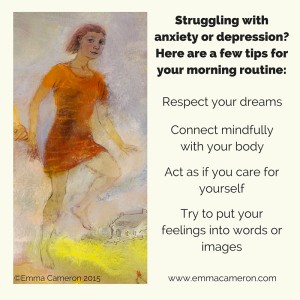 Are you prone to anxiety or depression?
Are you prone to anxiety or depression?
Probably the number one thing you can do to help yourself recover is to find a good counsellor or psychotherapist.
But there are also some very simple things that you can choose to do on a daily basis to help yourself heal faster.
How about starting with first thing in the mornings?
Here’s a sample morning routine that incorporates several recovery-boosting elements.
(And if you fancy creating your own personalised ideal morning routine, I’ve included a checklist at the end of this article to help you think about essential features to include).
7am: Before you get up
Listen out for your dreams
Take a moment to see if you can remember any dreams. If any dream fragments (or entire dream sequences) are available, let yourself be curious about them. Even scary dreams can be valuable and help you get a sense of something new and needed in your life.
Even scary dreams can be valuable, helping you get a sense of something new and needed. Share on XYour unconscious mind works hard when you sleep, sifting and sorting through the remnants of the previous day. Your dreaming imagination can be stunning in its bizarre inventiveness (if you’re one of those people who announces ‘I haven’t a creative bone in my body’ maybe you should start to recognise that a part of you is infinitely creative!)
Later in the day, you could take inspiration from your dreaming imagination and see where it leads you… drawing, singing, story-writing or other creative pursuits can all be inspired by dream images and happenings. Even if the audience for your creativity is only ever yourself, it can still be profoundly worthwhile and a very important aspect of keeping mentally healthy.
Connect with your body
Still lying in bed, do a quick body scan. Starting from your toes, notice how each part of your body is feeling, right now. See if you can just notice and accept any aches, pains or other sensations, rather than thinking about how you ‘should’ be feeling.
Find out what happens when you direct your attention inwards and try to pick up any sensations in your gut or heart areas. If you aren’t used to doing this, you may feel nothing at all. Persevere over many days, and eventually you will probably develop your ‘sixth sense’ — interoception, the sense that perceives the complex networks of neurones in those areas.
Why is that good? Because when you are more in touch with those parts of your body, you’ll be more in touch with your varied range of emotions. Feeling emotions in the body, and then (this bit’s crucial) practising identifying and naming them, means you’ll gradually become more able to regulate them.
And your emotions are a vital part of you, giving a sense of meaning and direction to your life. Trying to squash them and ignore them, tends to lead to them forcing their way into your awareness, often in a way that feels scary and uncontrolled.
Emotions give direction and meaning to your life. Share on XIf the only feelings you get are the familiar old feelings associated with anxiety or depression, don’t despair. Can you identify subtle changes and flavours in those feelings?
One exercise that can help is to imagine you are speaking with someone who claims to feel exactly the same way as you do. Think: what questions would you need to ask them to find out if they really did feel exactly like you?
7.15: Washing
When you’re washing, challenge yourself to be as ‘present’ as possible. As you soap or shampoo yourself, try to only think about the physical actions and sensations as you experience them right now. Can you really feel the texture of the washcloth on your skin? When your mind wanders (as it will – that’s what minds do), gently and kindly lead your thoughts back to the present moment.
 7.30: Getting dressed
7.30: Getting dressed
Dress with care.
I don’t mean get fussy with ironing and trying to put together the perfect outfit.
I mean, dress like you care for yourself.
Choose clothes that feel like ‘you’, but a slightly uplifted version of you. Pick colours that chime with a feeling you want more of.
Ditch the tight belts and pinching shoes! Wear clothes you can move in and that feel comfortable.
And when your own self-doubting (or even self-loathing) thoughts crowd round you as you look in the mirror, experiment with trying to be more appreciative of your body as it is.
Thank your body for all that it’s done for you, and tell it that you’re sorry for all the times when you’ve hated it and wished it were different. Okay, you may feel a bit inauthentic and false doing this at first, but keep ‘acting as if’ and gradually things may start to shift.
Be aware of your posture. Researchers are now finding that adopting more open, powerful-type poses (even just for a couple of minutes) can actually trigger a release of natural chemicals in your body that make you feel calmer and more in control.
Conquer #depression and #anxiety with morning routine tweaks. #MentalHealth Share on X
7.40: Breakfast
When you know that you’ve done something really good for yourself — like eating food that’s both healthy and yummy — it can be a huge boost to your mood. Starting well also makes it easier to continue caring for yourself through the day.
When you feel cared for, you feel better. And yes — absolutely, even when it’s you caring for yourself, it counts!
With only a small amount of forward planning, breakfast can be the easiest meal to eat healthily. Oatmeal porridge is incredibly cheap and very nutritious. Add a small amount of honey or golden syrup – and some berries or chopped fruit – and it’ll be delicious too.
7.55: Using touch
If you’re lucky enough to have someone around who you love, make a point of sharing extended hugs with them. Prolonged hugs calm and regulate your body and mind.
If you have a friendly dog or cat, spend time stroking or cuddling them – this can also have very beneficial effects on your mental (and physical) health.
What if you have no-one, and no pet? You can still benefit from touch.
Try putting your right hand on the other side of your chest, right round near your left armpit. Then with your left hand, hold your right arm just below the shoulder. Hold yourself gently but quite firmly and see if you can do this with a warm, caring attitude (don’t worry if you have to do this on quite a few occasions before you can sense even the beginnings of a loving attitude — keep practising and it will come in time). Keep on until you sense something inside you relaxing or subtly shifting in some way.
8.00 Get outside and move!
Numerous studies have shown that exercise (especially in natural surroundings) can make a huge difference to mood and mental health. Whether you opt for walking, running, swimming or cycling, the most important thing is to begin. If you can only manage 5 minutes, do that. Maybe make it 6 minutes next week; before long you’ll be building up to a significant 20 or 30 minutes, and improving both your mental and physical health enormously.
Boost your mental health with this morning routine. Share on XYour morning routine has to be tailored to what works for you.
Why not get creative and devise your own personalised anti-anxiety/ anti-depression morning routine? Try to make sure all of the following features are part of it:
- self-compassion
- gratitude
- mindfulness
- touch
- contact with the natural world
- moving your body
- contact with others
- trying to put words and/or images to your feelings
- respect and curiosity about your dreams and your imagination
- nutritious food
- acting as if you were your own loving, caring friend
All these features can be very helpful – once you get used to them, try to include them throughout the day, not just in the morning. And if this doesn’t feel like enough to overcome your anxiety or depression, I strongly advise that you try combining these self-help techniques with psychotherapy or counselling (possibly in conjunction with prescribed medication).
I’d love to hear how it goes. And if you have introduced something into your morning routine that you’ve found helps you, tell me in the comments below!

